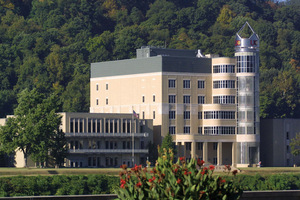 | Back to e-WV
| Back to e-WV
 The West Virginia Encyclopedia
The West Virginia Encyclopedia
 | Back to e-WV
| Back to e-WV
 The West Virginia Encyclopedia
The West Virginia Encyclopedia

The University of Charleston, an independent university situated on the Kanawha River opposite the West Virginia capitol, serves the greater Charleston community with a spectrum of academic and cultural opportunities. The institution offers a variety of programs at the associate and bachelor degree level, master’s programs in business and a doctoral degree in pharmacy.
The university was founded in 1888 as Barboursville Seminary, affiliated with the Methodist Episcopal Church South. Cabell County had moved its seat of government from Barboursville to Huntington, leaving a courthouse complex that served as the school’s initial campus. The early decades were ones of struggle as a series of presidents attempted to turn vision into reality. When a substantial gift from Morris Harvey, a Fayetteville coal operator, eliminated the early debt, the grateful institution changed its name to Morris Harvey College in 1901 and undertook a modest building and renovation program until Harvey’s death in 1907. Although aided by periodic enrollment growth, a successful financial campaign in the early 1920s, and a bequest from the estate of Rosa M. Harvey, it could operate only as a junior college from 1909 to 1919 and entered the 1930s unable to make payment on its debt.
In the next quarter century, Leonard Riggleman, the 19th president, led the college from the depths of the Depression to its modern role as a fully accredited institution located on a growing campus. Operating with payroll often unmet, Riggleman pursued the recurring idea of moving the college to the Charleston area. In an agonizing decision during which the Board of Trustees reversed itself three times within a week, the college accepted an invitation from the Charleston Education Center and opened in temporary quarters in downtown Charleston on September 11, 1935.
As enrollment soared, the equity in Barboursville was surrendered, civic leaders were placed on the board, and the college affiliated with Kanawha Junior College and the Mason College of Fine Arts and Music. World War II halted growth and also led the recently merged Methodist Church to decide to support only one institution in West Virginia. Rather than merge with West Virginia Wesleyan in rural Buckhannon, Morris Harvey College, in another painful decision, sought disaffiliation from the Methodist Church and became a self-governing, independent college in 1941.
Land for a permanent location was acquired during the war, and with enrollment reaching 2,000 by 1945, the college erected government surplus buildings, built a small cafeteria, and moved to its current location on September 8, 1947. With strong enrollments, the college set about building permanent facilities. The main administration and classroom building, appropriately named Riggleman Hall, was constructed in 1950–51. A significant turn in mission occurred in 1955 when the college built its first dormitory, and three more followed by 1966. A student union building in 1966 and a physical education building in 1969 expanded the riverside campus.
The academic program also proceeded in stages. Although the initial accreditation attempt failed in 1953, the faculty succeeded in defining the academic goals and program for the North Central accreditation agency in 1958, and the institution has maintained accreditation ever since. In 1964, Morris Harvey College entered the burgeoning field of health sciences, offering an associate degree in nursing in cooperation with area hospitals.
When Riggleman retired in favor of Marshall Buckalew in 1964, the college had never been stronger. Enrollment surpassed 3,000 under Buckalew’s leadership in the early 1970s. Thereafter an alarming decline began, putting increasing pressures on a heavily indebted institution. In 1974 Buckalew explored the possibility of affiliating the school with the state. Riggleman returned from retirement to oppose the plan, which ultimately was rejected by the state. In a dramatic move to change the image and fortunes of the school, new president Thomas Voss restructured programs, dismissed faculty, and renamed the institution the University of Charleston in 1978. The strategy had little immediate impact, and the university faced major crises in the mid-1980s before gradually turning around.
During the 1990s, under President Edwin Welch, the university entered a new period of strength and growth. The Clay Tower Building—the first new structure in a quarter century—was dedicated September 7, 1997, 50 years after Morris Harvey College occupied its permanent campus.
In 2003, the school revived its football team after a 47-year absence. The team now plays at the University of Charleston Stadium, which is home to Laidley Field. Other athletic facilities include the Bernard H. Wehrle, Sr. Athletic Arena for basketball and volleyball; Welch Athletic Complex for baseball, lacrosse, and soccer; a softball field; and the Morrison Fitness Center for students.
In August 2006, the university launched the School of Pharmacy in the new Robert C. Byrd Center for Pharmacy Education building. Through a partnership with Walmart, it became the first pharmacy school in the country to have a full-fledged corporate pharmacy on campus. The first class graduated from the pharmacy school in May 2010. In 2008, the university launched the Graduate School of Business & Leadership. The university also built three residence halls and a parking garage that includes student apartments.
In 2013, University of Charleston took over Mountain State University, a private college in Beckley that lost its accreditation in 2012. UC had a total enrollment of 2,926 in fall 2021 and 3,059 in fall 2022, its highest numbers since 1974.
University of Charleston website
Written by R. Eugene Harper
Krebs, Frank J. Where There is Faith: The Morris Harvey College Story, 1888-1970. Charleston: MHC. Publications, 1974.
Henderson, Mildred L. Birth of a College. West Virginia Review, (Sept. 1942).
Knight, Frank A. Morris Harvey: College with a Future. West Virginia Review, (Feb.-Mar. 1947).